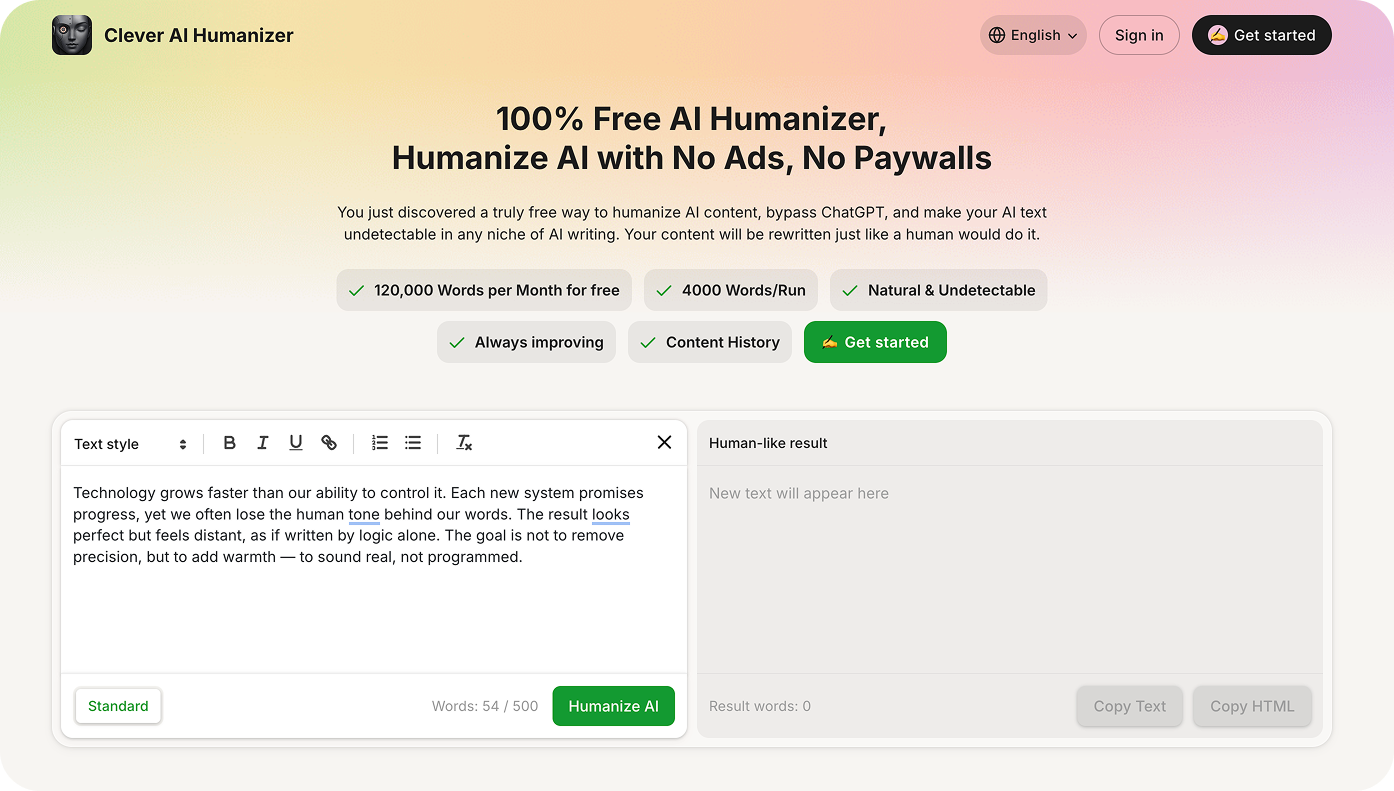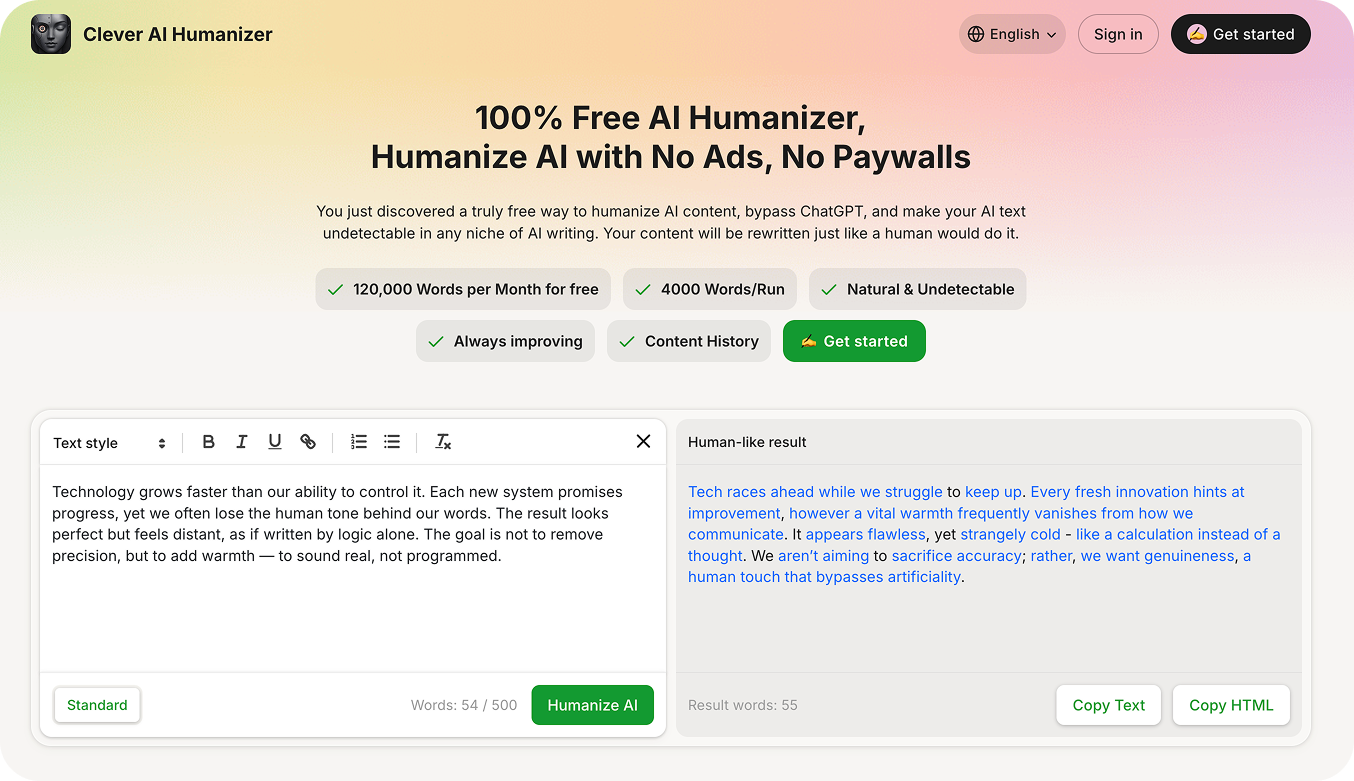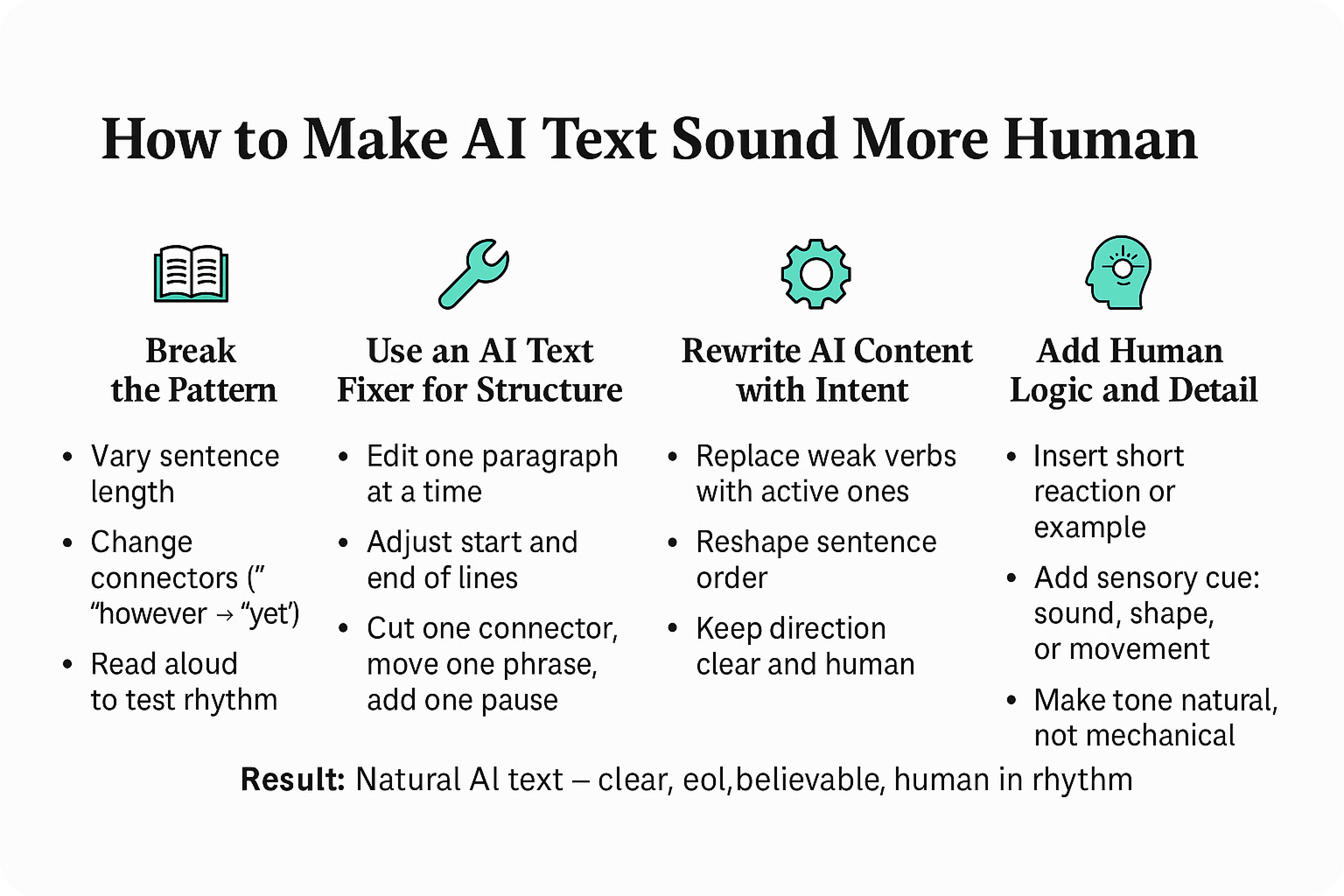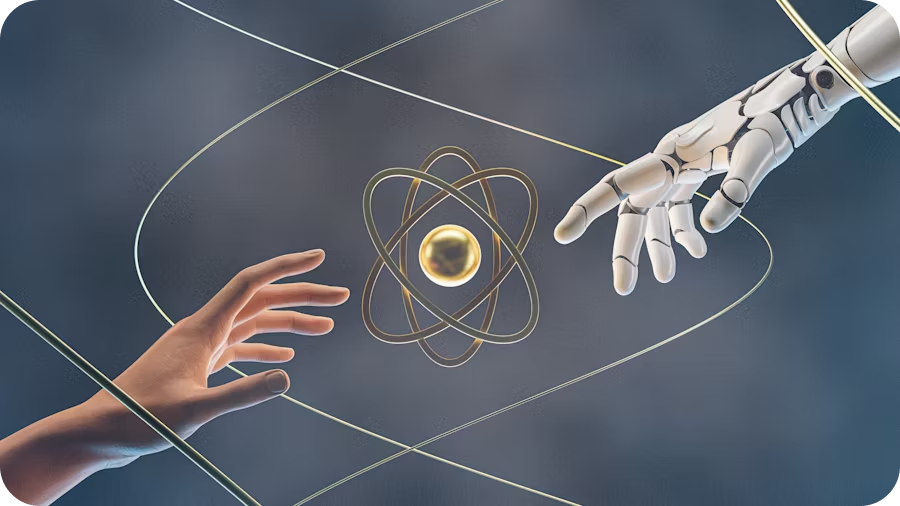
AI detection tools advance fast. Every line written by a model now leaves a trace. The new AI humanizer tool changes that - it reshapes text so it sounds natural, unpredictable, and fully human.
Writers, editors, and agencies already use these systems to rebuild tone and rhythm. They adjust phrases, shift sentence weight, and remove the mechanical tone that detectors track.
In this article, we’ll explain how modern content is built.
Why Every AI Text Can be Detected
Most AI writing tools build text through prediction, not through intent. Detectors reveal this logic by measuring repetition, tone stability, and word choice patterns.
Human sentences bend rules. They shift rhythm, pause mid-idea, or extend thoughts unevenly. AI systems follow a linear pattern that exposes their origin. When transitions stay too smooth or sentence length repeats, AI detection tools highlight the text as synthetic.
Top platforms such as ZeroGPT, QuillBot’s AI Detector, and Originality.ai measure three key factors:
- Perplexity - how unexpected each word appears.
- Burstiness - variation in sentence structure.
- Symmetry - balance across phrases and paragraphs.
When these numbers remain too consistent, detectors identify the text as machine-made. Even advanced generative AI writing leaves predictable signs.
Writers who try to avoid AI detection often discuss their results on Reddit, where users share how humanizer tools perform against current detectors.
The consensus stays the same - pure automation never sounds fully human. Every AI draft still needs a human pass before publication to restore voice and intent.
The Rise of New AI Creative Tools for Text
A new wave of AI humanizer tools now defines how writers rebuild and refine text. These platforms go far beyond a simple rewrite. Each AI humanizer tool online checks phrase patterns, sentence rhythm, and emotional tone to make machine text sound human.
Developers now treat humanization as a clear stage of text correction. A real humanizer fixes mechanical flow, removes repetition, and restores balance between logic and voice. Instead of replacing words, it changes how sentences connect, how stress moves, and how rhythm flows through a paragraph.
Modern AI humanizer tools use layered logic. They evaluate text as a reader would - by testing rhythm, tone, and sentence weight. Some rebuild flat tone with irregularities that sound natural. Others adapt tone for multiple languages while keeping the original meaning.
The most reliable free AI humanizer platforms now include filters that highlight repetitive structure before change. Users decide what to modify or keep, which gives better control over style and keeps text personal, not mechanical.
You can compare best free AI humanizer apps, but for this guide, we’ll walk through the usual process using Clever AI Humanizer. It’s one of the best tools available right now. In our tests, it delivered results that stood out.
How to Use an AI Humanizer Effectively
Now it’s time to put it into practice. With one of the best free AI content humanizer tools, you can quickly “fix” your text and make it sound a lot more “human” and significantly lower detection rates across most popular AI detectors.
Clever AI Humanizer fully complies with global privacy and data protection standards, including GDPR and CCPA. The tool also incorporates safeguards to prevent misuse, such as academic or copyright-related fraud.
How to humanize AI text correctly:
1. Open Clever AI Humanizer and paste a short part of your text into the input field. Short sections give more accurate results and help the system detect tone and rhythm correctly. You can see your text on the left side of the screen and the “Human-like result” panel on the right.

2. Fix and check. Press the “Humanize AI” button. The tool processes your text and displays a new version in the right panel. Read the result carefully. If it feels too neutral or still mechanical, shorten one line, change a connector, or rewrite a phrase directly in the editor. The preview updates in real time, so you can fine-tune the tone instantly.

3. Copy the humanized version from the right panel and run it through an AI detector such as ZeroGPT. Make a few manual edits until the text feels confident, natural, and consistent. Clever AI Humanizer saves your progress, so you can return and adjust past drafts anytime.
How to Make AI Text Sound More Human

AI humanizers solve many issues, yet they are not the whole answer. True quality still depends on the writer’s control, not just the tool. A few precise edits can fix that and avoid AI detection without losing clarity. The steps below show how to rebuild natural AI text with control and intent.
Break the Pattern
AI tools follow logic that repeats. When a paragraph feels flat, shorten one line and extend the next. Replace equal connectors such as “however” or “therefore” with sharper words like “yet” or “still.” This disruption breaks the rhythm that the detectors depend on. Read each line aloud - if the pace stays even, it still sounds artificial.
Use an AI Text Fixer for Structure
A trusted AI text fixer helps repair rigid flow without a full rewrite. Paste one paragraph at a time. Adjust the start and end of sentences so the section reads unevenly. Combine the tool with manual edits: cut one connector, move one phrase, and add one pause mark. A few shifts per paragraph remove the mechanical tone.
Rewrite AI Content with Intent
Do not process a full draft through automation. Work line by line. Replace common verbs with active ones, vary sentence length, and rearrange ideas. When you rewrite AI content this way, the text shows direction and purpose. It feels deliberate, not automatic.
Add Human Logic and Detail
AI forms facts, but humans express experience. Add a short reaction, a cause-and-effect note, or a quick example that feels real. A small sensory cue - sound, shape, or movement - turns sterile text into natural AI text. Readers trust rhythm and emotion more than precision.
Each step rebuilds tone that machines cannot create. A good AI humanizer tool can test results, but the final voice always depends on the writer.
The Human - AI Balance

Recent news across tech media shows the rapid growth of humanizer platforms. Each month, developers release new tools for AI writing that give deeper control over rhythm and tone. This technology helps creators rebuild structure, adjust phrasing, and maintain voice. Each AI humanizer service delivers clarity, turns mechanical text into natural language, and keeps every line precise, productive, and direct.
The best systems rarely pass as fully human. Each undetectable AI writer leaves rhythm marks and predictable phrases. To remove AI detection from text, editors use selective rewrite instead of full regeneration. A short tone shift or smaller sentence helps a paragraph pass AI detection and make AI writing sound more human.
Modern creators use new AI creative writing tools to refine automation. These systems allow users to shape emotion, sentence weight, and flow, creating results that feel effective, precise, and personal. Minor tone changes bring warmth without loss of accuracy or structure.
Writers treat automation as a creative partner. Machines build drafts; people restore rhythm and meaning. The result stays easy to read, balanced, and authentic - the mark of true creative writing.
False Positives with AI Detectors
In conclusion, one more topic needs attention - the growing debate about AI detectors. Many discussions now raise doubts about how often these systems make incorrect judgments and label text as machine-generated. One example appears on Reddit in the r/AcademicPsychology community, where a student reported that their original paper received a “100 % AI-generated” label, despite no model having been used.
Experts and teachers in the thread said that current detectors rely on rhythm and word choice instead of meaning. Because of this flaw, genuine text - especially by non-native writers - may appear artificial to software or look like simple paraphrasing from an AI model.
Some people note that even classic works such as The Bible or Mark Twain often cause false alerts. Others said these tools remain unstable and should not be used to decide whether a piece of text is human-made.
This case proves that AI detection is far from reliable. A precise tone or structured paragraph can lead to a wrong judgment. For writers, editors, and students, the safest step is to keep drafts, timestamps, and revision history instead of trusting automated checks.
The lesson stays clear: AI detectors may assist review, but they cannot replace context, evidence, or human reason.







